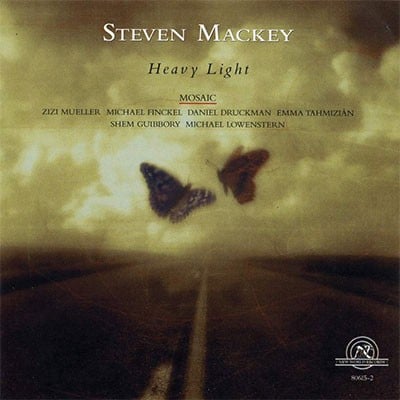fl.vc.pft.perc.egtr.pre-recorded tape
This work requires additional technological components and/or amplification.
Abbreviations (PDF)
Boosey & Hawkes (Hendon Music)
Heavy Light:
- Ritual
- First Crossing
- Psychedelic Fragment
- Second Crossing
- Voices
- Heavy Light
Heavy Light started life as a collaboration with choreographer Donald Byrd. MOSAIC and I visited Donald’s New York rehearsal studio and spent several days improvising with the dancers in a variety of scenarios. The piece is entirely notated (with the exception of a couple of improvised guitar solos) and none of material unearthed in the improv workshops made it into the piece. Yet, those improvisations led to the governing metaphor for the piece as a whole. Something about the sound of the electric guitar with the classical virtuosity of the MOSAIC core group and the free-form, pagan athleticism of Donald’s dancers suggested a “psychedelic” esthetic. During this workshop, Zizi Mueller brought in The Psychedelic Experience by Timothy Leary. This is Leary’s guide for using LSD to explore new realms of consciousness along the lines of the Tibetan Book of the Dead and it (the book, not LSD) led Donald and me further into the imagery and familiar tropes of sixties psychedelia— ritual; hallucination; spinning patterns; drones; chants; raga-like melodies; exotic percussion grooves; stylized mysticism; vivid contrasts between meditative and ecstatic states, between reflective and expressionistic modes; the sound of one hand clapping; embracing contradictions, (e.g. Heavy Light) … Donald and I wanted to explore the sensibility in which, at the time at least, it seemed that the experimental and avant-garde almost became mainstream; the sonic explorations of Jimi Hendrix counted as “popular” and the aspiration to transcend waking consciousness and achieve some kind of spiritual awakening was “normal.”
Heavy Light is a “trip” and “Ritual” is the longest (ten minutes) and densest part of the journey. It bears the responsibility for getting us to that “new realm” of consciousness in which we experience the hallucinations and “magic theater” of the rest of the piece. Like some sixties rock music, “Ritual” casts the electric guitar as something of a shaman priest beckoning and guiding, and the drums are the engine that powers the trip. In fact, I composed the entire percussion part first. The rest of the orchestration is built on the five phases of the drumming. It begins with primal rumblings—dropping tennis balls onto a bass drum—followed by a long limping, struggle that combines the relaxed, diffuse gesture of dropping the mallet heads onto the drums with intensely focused blows. This music is rhythmic, ritualistic and repetitive but not quite a groove. In time though, it evolves into a funky 4/4 groove that builds to a steady pounding sixteenth note. The final phase of the piece is a coda for percussion solo in which the bouncing motive is now moved to the delicate sound of mallet handles bouncing against the drum rims.
“First Crossing,” “Psychedelic Sketch,” “Second Crossing,” and “Voices” are dream sequences that inhabit the head-space (to use sixties parlance) induced by “Ritual.” Each of these interior movements focuses on a small rhythmic figure or gesture. “Psychedelic Sketch” is less evanescent and more developed than the others, and like “Ritual,” is driven by the percussion. The pattern that supports the languid melody in the first section clicks out the rhythm of what is to become the lively tune of the middle section. “Voices” is a recording of computer-manipulated voices and involves no live performance. The literal disembodiment is a turning point in the piece.
The last movement, Heavy Light,brings back the electric guitar as shaman priest and twice spins out a four-minute melody that had been alluded to in all of the preceding movements. Of all the music I’ve composed over the past twenty-five years, I think Heavy Light has the most explicit connection to my background as a rock guitarist. I think this is due to the subject matter and the fact that this is something of a “period piece.” Composing this piece reminded me that my aesthetic outlook was formed in large part by growing up in the sixties and seventies, in northern California with two older brothers. The “zeitgeist” of that time contributed to a fundamental assumption I have that the purpose of music is to explore new realms of consciousness. As a result, fragmented continuities, time warps and seemingly incongruous combinations of genre allusions (high art—low art) and instrumental combinations (electric guitar—acoustic chamber ensemble) are consistent preoccupations. Having said all that, I still think of myself as a composer in the concert music tradition of Mozart and Stravinsky: musical omnivores who showed, in their own music, a taste for ancient sacred music, learned counterpoint, and vernacular music (in the form of Austrian folk songs and Turkish marches for Mozart and Russian folk song and American jazz for Stravinsky), to name just a few of their influences.
Heavy Light was commissioned by MOSAIC and premiered in 2001.

Steven Mackey/Mosaic
New World NW80615

